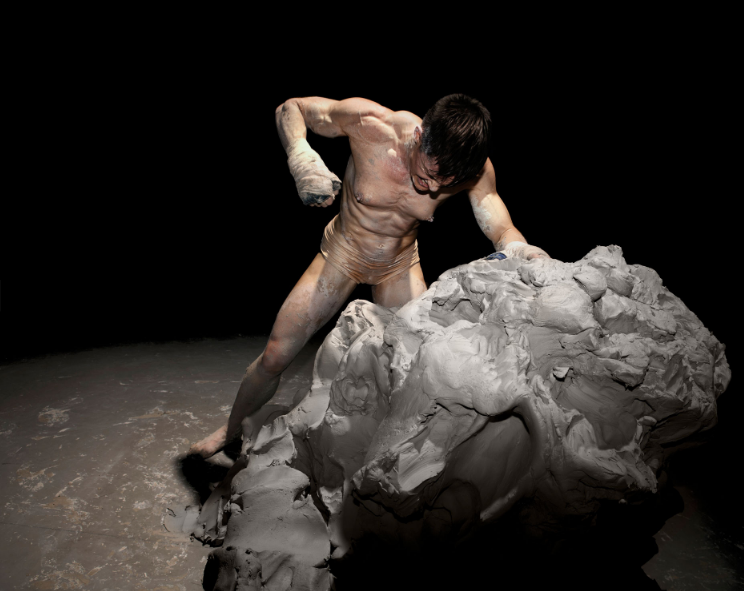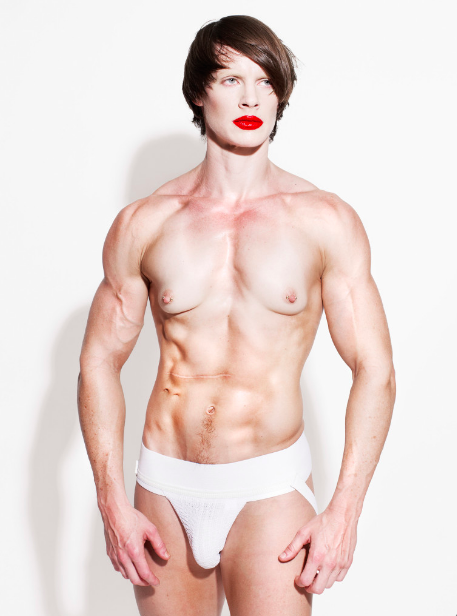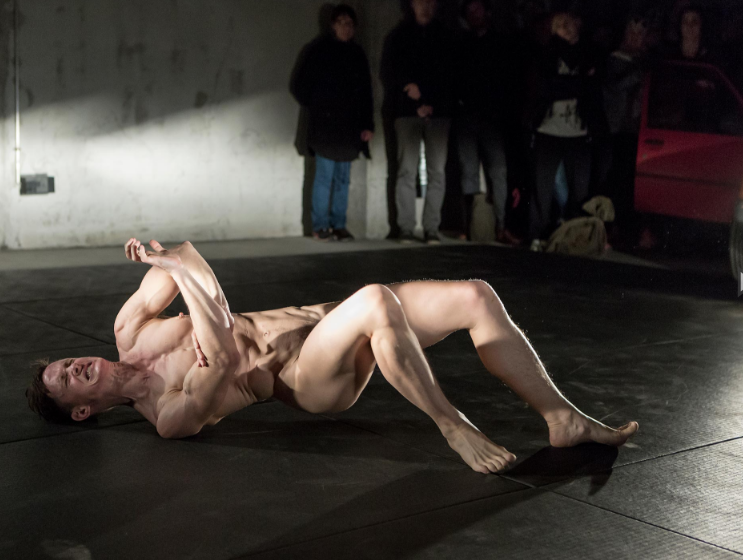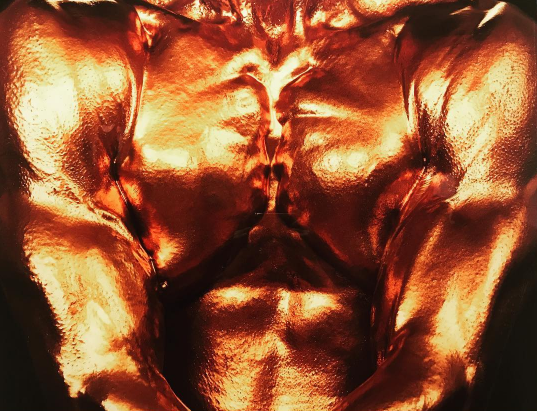You can– and should– check out Cassils' Monumental at Ronald Feldman Fine Arts through October 28th. For more information about their work, check out their website.
During the opening night of Cassils' latest show “Monumental,” the artist could be found intently watching their audience from a platform that rose almost 6-feet into the air.
Cassils' presence was the personification of power.
Their sight was full of emotion, it informed the room about the serious intent of their work. The fact that they were watching us all from an elevated angle made us feel hyper-aware of our own observation of their artwork and of our understanding of its meaning.
[anad]
One of the highlights of this exhibit was "PISSED", a glass sculpture containing 200 gallons of urine collected by Cassils since the Trump administration rescinded transgender students’ choice to use the bathroom that matched their chosen gender identities.
The dark quality of the urine that flowed inside "PISSED" served as a reminder that what was upon us was indeed bodily waste and that it was there for a purpose.
Cassils' display of emotion coupled with the gut-wrenching soundtrack of transgender children narrating the biases and ignorance that surrounds the negotiation of their human rights, gave rise to a tense and serious atmosphere.
No one was smiling. Everyone was watching the artist attentively. People seemed to be whispering so as not to disturb the flow of the soundtrack’s soundwaves bouncing around the room’s walls. The audience was getting the seriousness of Cassils' work.
This work is deeply personal for Cassils. “I see my practice as a process of creating images that empower,” they said, “but also those that point to the atrocities and hate crimes that are still happening every day.”
The purpose of “PISSED" was therefore clear: to shine a spotlight on the issues that affect transgender communities and therefore to spark up debate about the different strategies that activists should use to ameliorate these.
For the last two decades, Cassils, who lives in Los Angeles, has been creating artworks and performances that offer shared experiences and in turn allow their viewers to contemplate and empathize with histories of “violence, representation, struggle, and survival”.
For instance, in the 2012 performance “Becoming an Image,” (above) Cassils unleashed a physical attack on a 2000 pound block of clay with the goal of smashing the weight of accountability about the oppression, murder, and abuse of trans people directly onto the audience.
Their work has therefore always strived to shed a spotlight on the issues that afflict the trans community, as well as hold viewers accountable for the continuance of these issues, whether it is by reasons of ignorance or inaction.
“Inextinguishable Fire,” another one of the highlights of this show, was an immersive audiovisual experience, which showcased Cassils' body surrounded by volatile flames. This piece aimed to engage its audience with images of violence and war.
“Inextinguishable Fire’s” slow-motion video was accompanied by several glass blown sculptures, which according to the artist, “encapsulate the form of a single breath that resembles fragile speech bubbles and spoke to the precarity of voice and political expression.”
The overall effect achieved by this piece was one of full-immersion. The combination of the soundtrack that played Cassils’ breaths with the arresting yet calming sight of flames dancing around Cassils body, almost made it seem as if we could feel the warmth emanating from the video’s flames.
This immersive performance had the purpose of making the audience see Cassils’ body not as fixed, but as in a constant state of flux. In other worlds, Cassils’ body became an “abstracted human form engulfed in flames,” which according to the artist, had the potential to lead the audience to “place themselves in that position for a moment and think about what it would be like to be subjected to that violence.”
[anad2]
Creating these artworks and performances takes time and strenuous preparation. Cassils, for instance, had to carefully craft a methodology that made the live performance of “Inextinguishable Fire” completely safe, and adopted a rigorous physical training practice months before presenting “Becoming an Image.”
Cassils’ performances, which involve their blood, sweat, bodily wastes, and sinew, aim to “construct a visual critique around ideologies and histories.” Crafting the methodologies and mediums that they are going to use to bring these to life “requires a great deal of meditation,” they said.
Cassils’ work has often inspired strong reactions. In Berlin, for example, ads for their exhibit “Homage to Benglis" (above) got banned due to the fact that critics deemed these ads’ photos “sexist, sexualized, and pornographic.”
On the other hand, the 2015 live performance of “Inextinguishable Fire” in Los Angeles, inspired an intense empathetic physical reactions amongst the audience. “People said they were sick to their stomachs, that they were shaking,” Cassils said.
Their performances always aim to be shocking and hence to forever inhabit our collective memories. During “Monumental’s” opening night, for instance, Cassils peed through a pink plastic cup into one of the orange colored containers that they had used for the last eight months to store their urine.
They were therefore not satisfied with the imagery that "PISSED" pushed forward; they wanted to confront us with the fact that the liquid flowing inside this piece was not make belief, that it actually originated from their body.
Cassils’ choice to be at the center of their performances has a purpose and it is to use their body “as a medium,” and as “a sculptural mass with which to rupture norms and bash binaries.” In other words they “perform transgender not as a crossing from one sex to another but rather as a continual process of becoming.”
This artist’s body of work has consistently utilized the display of their body as a means to put forward a meaningful political message. This was specifically the case on the “Powers That Be” performance (above). In this piece Cassils' naked body viciously fought an invisible other that choked, dragged and pinned them down.
“With this piece, I wanted to talk about more than just my body,” the artist said, “I wanted it to be bigger than my own subjectivity, to include other things beyond. Using the airwaves and the absent figure, you could have projected on that absence all these larger issues that aren’t being spoken about — issues around race, class, gender, religion.”
Similarly, in Alchemized, now showing at the Ronald Feldman Gallery, Cassils photographed their body as a series of “torqued metallic abstractions and gilds,” with the intent of exalting the state of “self-determined trans embodiment.”
In this sense, Cassils' work intently puts their audience face to face with the transgendered body in order to de-mystify it and therefore to allow their audience to become aware of its inherent beauty.
Overall, Cassils’ purpose as an artist is to engage its audience with “performative actions that create a ripple effect in the minds and bodies of those who experience them,” they said.
Note on Gender and Pronoun Usage
Cassils is a gender non-conforming trans masculine visual artist. Cassils uses plural gender-neutral pronouns (they, them, their), a single name (as opposed to first and surname), and asks that journalists do likewise when referring to them. This singularity of name and plurality of gender reflects through language the position Cassils occupies as an artist.
For guidelines on writing about gender non-conforming people, please reference the GLAAD Media Reference Guide on Transgender Issues.
[Feature Image Courtesy Cassils and Ronald Feldman Gallery, New York]






